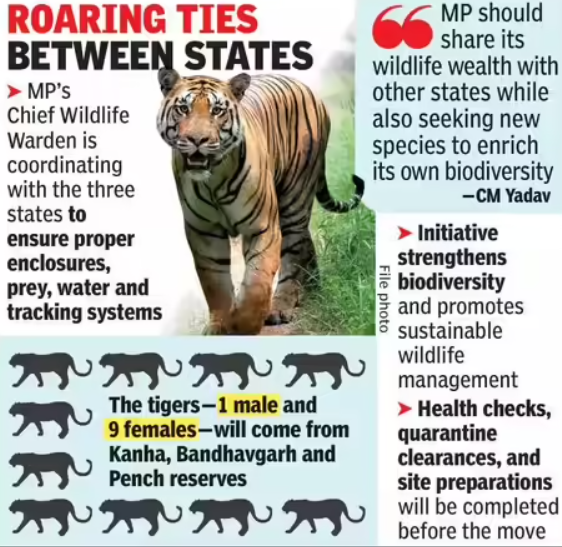Madhya Pradesh Switch to Hindi
MP to Relocate Tigers to Neighbouring States
Why in News?
Madhya Pradesh, the ‘Tiger State of India’ with the country’s largest tiger population, will relocate one tiger and nine tigresses to Odisha, Rajasthan, and Chhattisgarh under an inter-state conservation plan, following an earlier unsuccessful attempt to send tigers to Odisha.
Key Points
- About: The translocation is part of an inter-state wildlife cooperation initiative aimed at enhancing tiger populations in reserves with low density and strengthening India’s overall conservation network.
- Madhya Pradesh Chief Wildlife Warden has written to his counterparts in the three states, directing them to make necessary preparations for tiger relocation.
- Preparatory Measures: The states have been asked to submit details on:
- Availability of enclosures and prey base
- Installation of radio collars for tracking
- Status of water resources
- Human interference around the release sites
- Approval: The initiative follows the approval of Chief Minister Mohan Yadav during the 30th meeting of the State Wildlife Board.
- Source Reserves: Tigers for relocation will be translocated from Kanha, Bandhavgarh, and Pench Tiger Reserves, all of which have stable and growing tiger populations.
- Implementation: The translocation will begin once Health checks are completed, Quarantine protocols are cleared, and Final logistical arrangements are in place across all three recipient states.
- Significance: The initiative is significant as it promotes balanced tiger distribution to ease population pressure in dense habitats, enhances genetic diversity by facilitating gene flow, and helps restore ecological balance in underpopulated reserves.
National Current Affairs Switch to Hindi
UN Troop Contributing Countries (UNTCC) Chiefs Conclave 2025
Why in News?
The United Nations Troop Contributing Countries (UNTCC) Chiefs Conclave 2025, hosted by the Indian Army from 14th to 16th October 2025, brought together senior military leaders from 32 nations that play a key role in global UN peacekeeping operations.
Key Points
- About: The conclave is attended by senior military officials from 32 nations, including Algeria, Armenia, Australia, Bangladesh, Brazil, Egypt, Ethiopia, France, Ghana, India, Italy, Kenya, Malaysia, Nepal, Nigeria, Poland, Rwanda, Sri Lanka, Tanzania, Thailand, Uganda, Uruguay, and Vietnam.
- The event also features defence exhibitions aimed at building shared capacities for peacekeeping missions.
- Objectives: The UNTCC serves as a vital forum to address operational challenges, evolving threats, interoperability, inclusivity in decision-making, and the role of technology and training in strengthening UN peacekeeping.
- India, one of the largest contributors to UN peacekeeping, has convened this high-level forum to discuss best practices, share insights, and build mutual understanding for future peacekeeping.
- Technology Demonstration: The chiefs witnessed a demonstration of integrated, new-age military technology by the Indian Army, showcasing various indigenous military equipment.
- 4C Formula for UN Peacekeeping: Defence Minister Rajnath Singh proposed a guiding principle of enhanced Consultation, Cooperation, Coordination, and Capacity Building (4C) to address emerging challenges in peacekeeping.
- He noted that the Centre for UN Peacekeeping in New Delhi has trained participants from over 90 countries, contributing significantly to the development of interoperability among peacekeepers.
United Nations Peacekeeping (UNPK)
- The first UNPK mission, the United Nations Truce Supervision Organisation (UNTSO), was established in May 1948 to monitor the Armistice Agreement between Israel and its Arab neighbours with a small team of military observers.
- They are deployed by the UN Security Council to support ceasefires and peace agreements and are called Blue Helmets due to the light blue colour symbolising peace on the UN flag.
- Currently, over 61,000 military and police peacekeepers from 119 countries and more than 7,000 civilian personnel serve in 11 UN Peacekeeping Missions.

English.gif)



 PCS Parikshan
PCS Parikshan

 Chiefs Conclave 2025.png)


